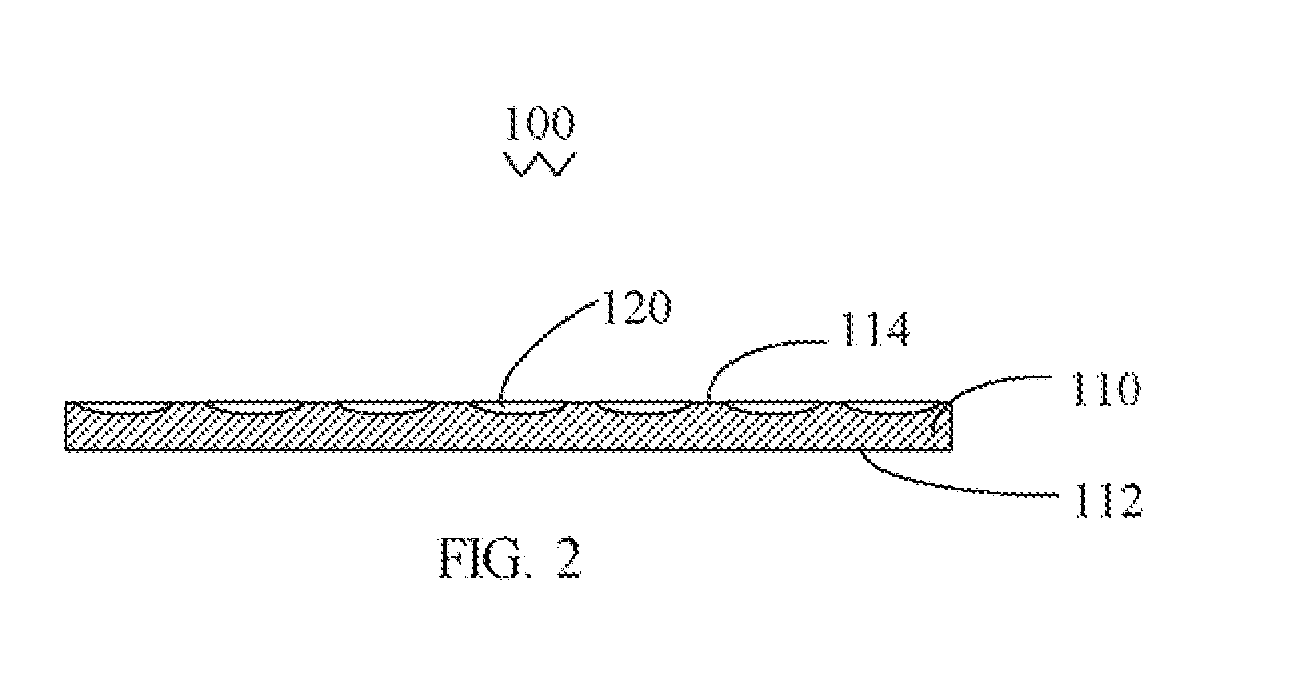Polarizer and liquid crystal display employing same
a technology of liquid crystal display and polarizer, which is applied in the direction of optics, instruments, optical elements, etc., can solve the problems of approximately 50% of the light beams emitted by the backlight module being lost before reaching the liquid crystal layer, and the liquid crystal used in lcds is not self-luminescen
- Summary
- Abstract
- Description
- Claims
- Application Information
AI Technical Summary
Benefits of technology
Problems solved by technology
Method used
Image
Examples
first embodiment
[0018]Referring to FIGS. 1 and 2, a polarizer 100 is shown. The polarizer 100 includes an optical anisotropic transparent substrate 110. The substrate 110 includes a light incident surface 112 and a light emitting surface 114. The light emitting surface 114 is opposite to the light incident surface 112. The substrate 110 defines a plurality of grooves 120 in the light emitting surface 114. The grooves 120 are oriented in an essentially identical direction.
[0019]The substrate 110 should at least allow visible light (i.e., with a wavelength from 390 to 760 nanometers) to pass therethrough. A thickness of the substrate 110 is in an approximate range from 1 to 10 millimeters (mm), and is more preferably in an approximate range from 2 to 5 mm. In the present embodiment, a material of the substrate 110 is calcite. The calcite allows a light with a wavelength in an approximate range from 350 to 2300 nanometers (nm) to pass therethrough. Alternatively, the material of the substrate 110 may...
second embodiment
[0021]Referring to FIG. 3, a polarizer 200 is shown. The polarizer 200 is similar to the polarizer 100, but further includes an antireflective coating 230 on the light emitting surface 214. The antireflective coating 230 allows a visible light to pass therethrough. The antireflective coating 230 includes a first titanium dioxide coating with a thickness in an approximate range from 10 to 16 nm formed on the light emitting surface 214, a first silicon dioxide coating with an approximate thickness of 26 to 32 nm formed on the first titanium dioxide coating, a second titanium dioxide coating with an approximate thickness of 80 to 120 nm formed on the first silicon dioxide coating, and a second silicon dioxide coating with an approximate thickness of 78 to 86 nm formed on the second titanium dioxide coating. Interference between multiple coatings of the antireflective coating can decrease reflection of incident light.
[0022]The coating step may be a vacuum coating process. The vacuum co...
PUM
| Property | Measurement | Unit |
|---|---|---|
| thickness | aaaaa | aaaaa |
| aspect ratio | aaaaa | aaaaa |
| depth | aaaaa | aaaaa |
Abstract
Description
Claims
Application Information
 Login to View More
Login to View More - R&D
- Intellectual Property
- Life Sciences
- Materials
- Tech Scout
- Unparalleled Data Quality
- Higher Quality Content
- 60% Fewer Hallucinations
Browse by: Latest US Patents, China's latest patents, Technical Efficacy Thesaurus, Application Domain, Technology Topic, Popular Technical Reports.
© 2025 PatSnap. All rights reserved.Legal|Privacy policy|Modern Slavery Act Transparency Statement|Sitemap|About US| Contact US: help@patsnap.com



